The world of conversational AI keeps growing, with countless platforms promising to be the best choice for businesses of all shapes and sizes.
Whether you’re looking to deploy an AI chatbot that answers customer questions or build an AI agent that proactively guides sales conversations, choosing the right platform can feel overwhelming.
Botpress and Kore.ai both stand out as top AI agent builders. Each offers unique strengths for businesses depending on how sophisticated and how customizable your AI projects need to be.
Wondering how each platform differs? Let’s dive into Kore.ai vs. Botpress.
Quick Overview: Kore.ai vs. Botpress
TL;DR: Both Kore.ai and Botpress can deliver sophisticated AI assistants but choosing the right one depends on whether teams value enterprise structure or ultimate flexibility.
Both Kore.ai and Botpress help businesses build powerful AI agents. The key difference between Kore.ai and Botpress lies in who they’re built for and how much structure versus freedom they offer.
Kore.ai is a no-code platform purpose-built for large enterprises that need to deploy sophisticated AI solutions at scale. It emphasizes governance, security, and pre-built enterprise integrations, making it ideal for organizations with complex internal structures and strict compliance requirements.
Botpress is designed for teams who want complete flexibility and ownership over their conversational AI. It combines a visual flow builder with the ability to write custom code, giving developers the freedom to tailor every part of the bot experience. Botpress is ideal for businesses who want to build deeply customized solutions beyond out-of-the-box templates. Botpress’s pricing is lower than Kore.ai, making it a great option for everyone.
Key Features of Kore.ai
- Visual dialog builder for creating multi-step conversations without coding
- Extensive pre-built integrations with enterprise apps
- Support for voice and IVR channels to build voice-based virtual assistants
- Built-in NLP engine for advanced intent recognition and entity extraction
- Role-based access control (RBAC) and robust enterprise security and compliance (SOC 2, HIPAA, GDPR)
- Centralized analytics and reporting tools for monitoring bot performance
- Enterprise governance features for managing bots across multiple teams
- Access to training resources and dedicated enterprise support teams
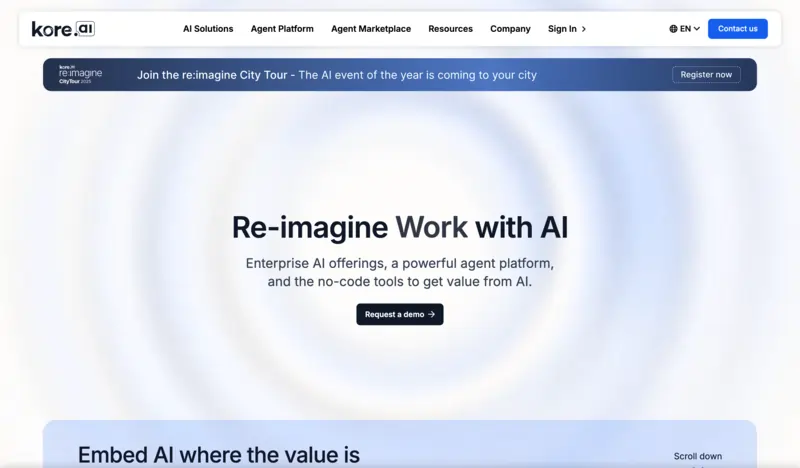
Key Features of Botpress
- Visual flow builder for designing complex conversations and workflows
- Unlimited integration options to connect with APIs, databases, and third-party tools
- Persistent memory to retain user context and conversation history across sessions
- Support for custom code execution for advanced logic and custom functionalities
- Choice of any large language model (LLM) for powering AI responses
- Role-based access control (RBAC) and enterprise-grade security features
- Built-in analytics and monitoring tools for tracking bot performance
- Active developer community and resources like Botpress Academy for support
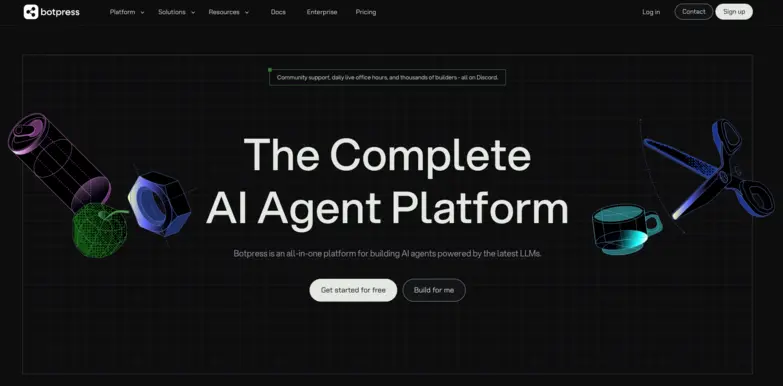
Feature-By-Feature Comparison
Kore.ai vs. Botpress Pricing Comparison
Kore.ai uses custom pricing for each of its AI products, tailored to enterprise deployments. While exact costs vary, most implementations are estimated to start around $300,000 per year, putting it firmly in the enterprise budget range.
Botpress, by contrast, offers transparent pricing tiers that make it far more accessible for businesses of all sizes:
Ultimately, for affordability and ease of entry, Botpress is the better choice.
Kore.ai is better suited for enterprises with large budgets, while Botpress makes powerful conversational AI achievable even for smaller teams and businesses.
Integration Capabilities
Both Kore.ai and Botpress handle integrations well, but they differ in how much flexibility they offer.
Kore.ai includes 100+ pre-built integrations for tools like Salesforce, ServiceNow, Microsoft Dynamics, and SAP. It’s great for enterprises that want to quickly deploy AI agents for tasks like updating CRM records or managing helpdesk tickets without building everything from scratch. While Kore.ai does support APIs and webhooks, its real strength is in ready-made integrations.
Botpress offers 190+ pre-built integrations for platforms like Slack, WhatsApp, Facebook Messenger, Zendesk, and HubSpot. It also gives developers the tools to build custom integrations using APIs and SDKs, making it ideal for teams who want to connect bots to specialized workflows and create highly tailored bot experiences.
Bottom line, Kore.ai is best for enterprises looking for quick, out-of-the-box integrations, while Botpress shines for businesses that need the freedom to integrate with any system and customize deeply.
Security Features
Language Understanding & Data Integration
TL;DR: Go with Kore.ai if you want built-in tools for managing and fine-tuning how your bot understands language, all within a no-code interface. Choose Botpress if you want the flexibility to connect different AI models, integrate external data sources, and customize how your bot processes information.
Kore.ai and Botpress both:
- Use NLP engines to understand user intents and extract entities.
- Allow integration of large language models (LLMs) for advanced language tasks and generative responses.
- Offer tools for testing and tuning how bots interpret user inputs to ensure accuracy.
Kore.ai uses its proprietary NLP engine and focuses on delivering these capabilities through a no-code interface. It’s designed for enterprises that want built-in tools for managing large datasets and fine-tuning bots without writing code.
Botpress also supports NLP and LLMs but emphasizes flexibility. Developers can mix different AI models, decide which models handle specific tasks, and integrate external data sources like APIs. In Botpress, users can connect an API to their CRM, enabling the bot to retrieve real-time customer details and blend that data with answers from an LLM, generating personalized responses on the fly.
Community & Support
TL;DR: Both Kore.ai and Botpress offer strong enterprise support with dedicated account managers, onboarding help, and personalized assistance for bot projects. The biggest difference is in community size and openness: choose Kore.ai if you want structured, company-led support and training; choose Botpress if you want a large, active open-source community alongside formal enterprise services.
Kore.ai and Botpress both:
- Provide dedicated account managers for enterprise customers.
- Offer onboarding assistance and personalized help with implementing bots and integrations.
- Maintain documentation and learning resources for users to self-serve.
Kore.ai focuses on larger enterprises seeking formal support channels. Beyond enterprise services, it offers a community forum of around 2,400 users, but the community is smaller and less open-source driven. Users typically rely on Kore.ai’s official channels for learning and support rather than community-led resources.
Botpress provides enterprise support but goes further with community engagement. Over 30,000 developers participate in Botpress’s Discord, actively sharing knowledge, troubleshooting issues, and participating in daily AMAs hosted by the Botpress team. Additionally, Botpress provides extensive public learning resources, including YouTube tutorials and Botpress Academy.
Customization & Flexibility
TL;DR: Go with Kore.ai if you want pre-built solutions that ensure consistency across channels with controlled customization. Choose Botpress if you want maximum flexibility to build custom bots, write your own logic, and integrate deeply with unique systems.
Kore.ai and Botpress both:
- Support deploying bots across multiple channels (e.g. web, WhatsApp, MS Teams).
- Allow some level of customization for conversation flows and integrations.
Kore.ai is designed for enterprises that value consistency. While you can customize conversation flows, integrations, and user experiences, changes often go through governance layers (like approval processes) to maintain security and compliance.
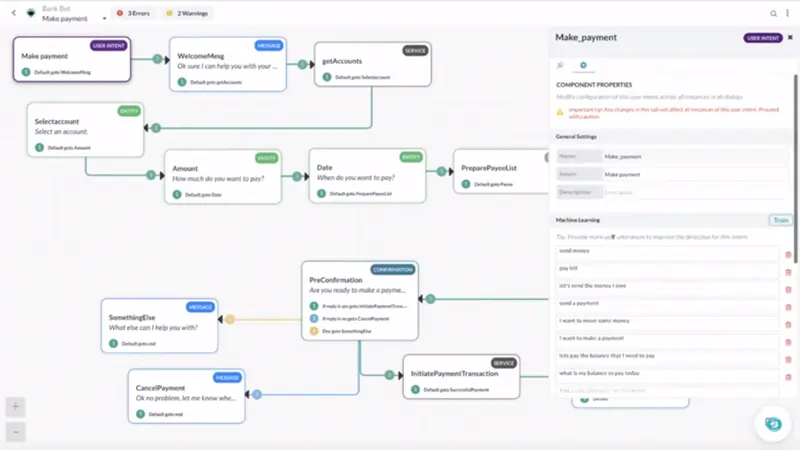
Botpress is built for flexibility. Developers can write custom code, design unique conversation logic, and integrate bots with any external system through APIs. This makes Botpress suitable for teams building highly specialized solutions or experimenting with new conversational designs.
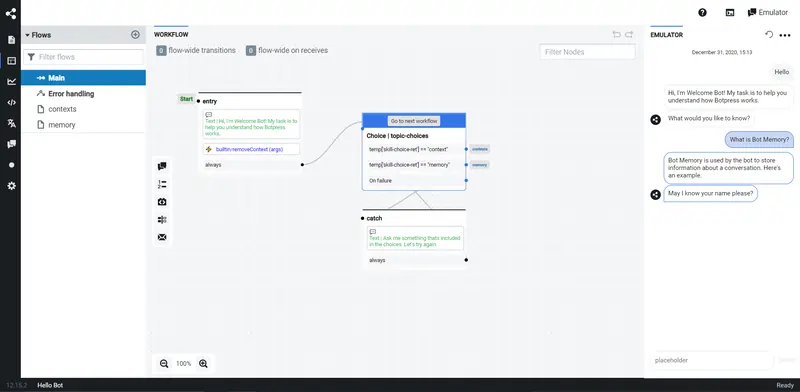
Is Botpress or Kore.ai better for my business?
The Lead Generation Scenario
Key problem: Converting website visitors into qualified leads
David runs marketing for a SaaS platform targeting enterprises. He wants a chatbot that can qualify leads and trigger personalized email sequences based on user interactions. David needs:
- Smart conversation flows for lead qualification
- Deep integrations with CRM systems
- Flexibility to tailor follow-up actions
Botpress is a better fit for SaaS businesses like David’s because it focuses on flexibility and cost-effectiveness. Developers can easily connect bots to marketing tools, design custom lead-qualification logic, and automate personalized follow-ups such as email sequences or push notifications. Plus, Botpress’s pricing is lower than Kore.ai’s enterprise costs, making it a great option for SaaS businesses that want powerful capabilities without a six-figure investment.
Kore.ai is also usable for lead generation. However, Kore.ai is designed around large-scale deployments and enterprise-grade governance, which often comes with higher costs and more structured processes.
For David’s SaaS business, unless he specifically needs Kore.ai’s enterprise compliance or advanced voice capabilities, Botpress is the more agile and cost-effective choice for AI lead-generation.
Bottom line: For David’s scenario, Botpress is usually the better fit if he wants flexibility, lower costs, and the freedom to customize lead gen workflows. Kore.ai could be the choice if his SaaS platform operates at large enterprise scale and requires advanced compliance or enterprise support.
The Personalized Sales Scenario
Key problem: Personalized product recommendations and sales assistance
Emma leads digital sales for a medium-sized e-commerce brand. She wants an AI assistant that can remember customer preferences, suggest tailored products, and handle conversations across web and messaging channels. Emma needs:
- Persistent memory to remember returning customers
- Integration with product databases for real-time recommendations
- Ability to create personalized sales journeys
For the personalized sales scenario, Botpress is the stronger fit. Botpress offers persistent memory to keep track of returning customers and integrates easily with product databases. Botpress’ flexible architecture lets Emma’s team tailor conversations to individual users, creating tailored product discovery and personalized shopping experiences. Importantly, Botpress’ pricing is far more affordable for medium-sized businesses, avoiding the steep costs tied to enterprise-focused platforms.
Kore.ai can handle personalized sales too but isn’t as ideal for medium-sized organizations. However, Kore.ai is primarily built for big enterprises and comes with higher costs and more complex setup.
Bottom line: For Emma’s scenario, Botpress is the better choice for building an AI sales agent. Kore.ai could be an option if her brand grows into a large enterprise needing advanced governance and compliance features.
The Customer Service Scenario
Key problem: Handling complex customer service queries across multiple channels
Priya manages customer experience for a large bank. Her team needs a chatbot that can handle voice calls, chatbots, and escalate issues when necessary, all while ensuring compliance with industry regulations. Priya needs:
- Multi-channel support, including voice and IVR
- Robust security and compliance
- Centralized management across departments
For the customer service scenario, both Kore.ai and Botpress are strong fits.
Kore.ai offers extensive support for web chat and messaging channels out of the box, with pre-built templates for banking use cases and robust enterprise-grade compliance (SOC 2, HIPAA, GDPR, etc.). It provides centralized governance, making it easier for Priya’s team to manage bots across multiple departments and ensure consistent customer experiences. And as a large bank, Priya’s organization likely has the budget to invest in Kore.ai’s enterprise-grade solution.
Botpress can handle complex customer service needs. Botpress enables multi-channel support through integrations and offers developers fine-grained control over bot logic and custom workflows. Its open-core nature and on-premises deployment option give banks full visibility and control over data security and compliance. Botpress excels in enabling teams to build highly tailored solutions that integrate deeply with proprietary banking systems via APIs.
Bottom line: For Priya’s banking use case, both Kore.ai and Botpress are strong contenders. Kore.ai provides more out-of-the-box enterprise features and faster deployment, while Botpress offers greater flexibility and developer control for highly customized solutions. Priya’s choice comes down to her team’s preference between speed of implementation versus deep customization.
The Bottom Line: Botpress vs Kore.ai
Botpress and Kore.ai are both strong AI platforms, but they’re built for different kinds of teams.
Kore.ai is great if users are looking for ready-made AI agents and a no-code setup. It’s perfect for getting bots up and running fast across multiple channels but it can feel limiting if users want to create something truly unique.
Botpress is all about flexibility and control. Instead of sticking to prebuilt templates, it gives developers the tools to craft AI agents tailored exactly to their processes and integrations.
FAQs
How do Botpress and Kore.ai handle multilingual bots?
Botpress and Kore.ai both support multilingual bots for global audiences by leveraging language models and translation capabilities, but they approach it differently. Botpress allows you to plug in any large language model (LLM) or external translation API, giving developers control over how each language is managed. Kore.ai includes built-in support for multiple languages in its no-code tools, letting enterprises manage translations and intent training centrally without coding.
Are there differences in how quickly updates or bug fixes are rolled out on Botpress versus Kore.ai?
There are differences in how quickly updates or bug fixes roll out on Botpress versus Kore.ai because of their development models. Botpress releases frequent updates and hotfixes driven by both user feedback and internal development. Kore.ai, as a strictly enterprise SaaS solution, follows more controlled release cycles, so updates may be less frequent but undergo rigorous testing before deployment.
How customizable are user interface elements (like chat widgets) in Botpress compared to Kore.ai?
User interface elements like chat widgets are more customizable in Botpress than in Kore.ai. Botpress lets developers modify front-end components directly or integrate with custom UIs using APIs and SDKs, offering total control over the look and feel. Kore.ai also offers customization options, but these are generally confined to styling and configuration within their enterprise platform rather than full front-end development freedom.
How steep is the learning curve for non-developers on Botpress vs. Kore.ai?
The learning curve for non-developers is generally steeper on Botpress than on Kore.ai. Kore.ai is built around no-code tools and pre-configured templates, making it more approachable for business users who want to build bots without writing code. Botpress provides no-code options but focuses heavily on developer flexibility and custom coding, which means non-technical users may require more time and training to build complex bots.
How do Botpress and Kore.ai handle long-term bot maintenance and versioning?
Botpress and Kore.ai both handle long-term bot maintenance and versioning but with different mechanisms. Botpress uses a combination of version control integrations (like Git) and environment management, allowing developers to track changes and maintain separate bot versions. Kore.ai provides enterprise-grade governance with built-in versioning tools, allowing teams to manage bot updates and deployments across multiple business units.
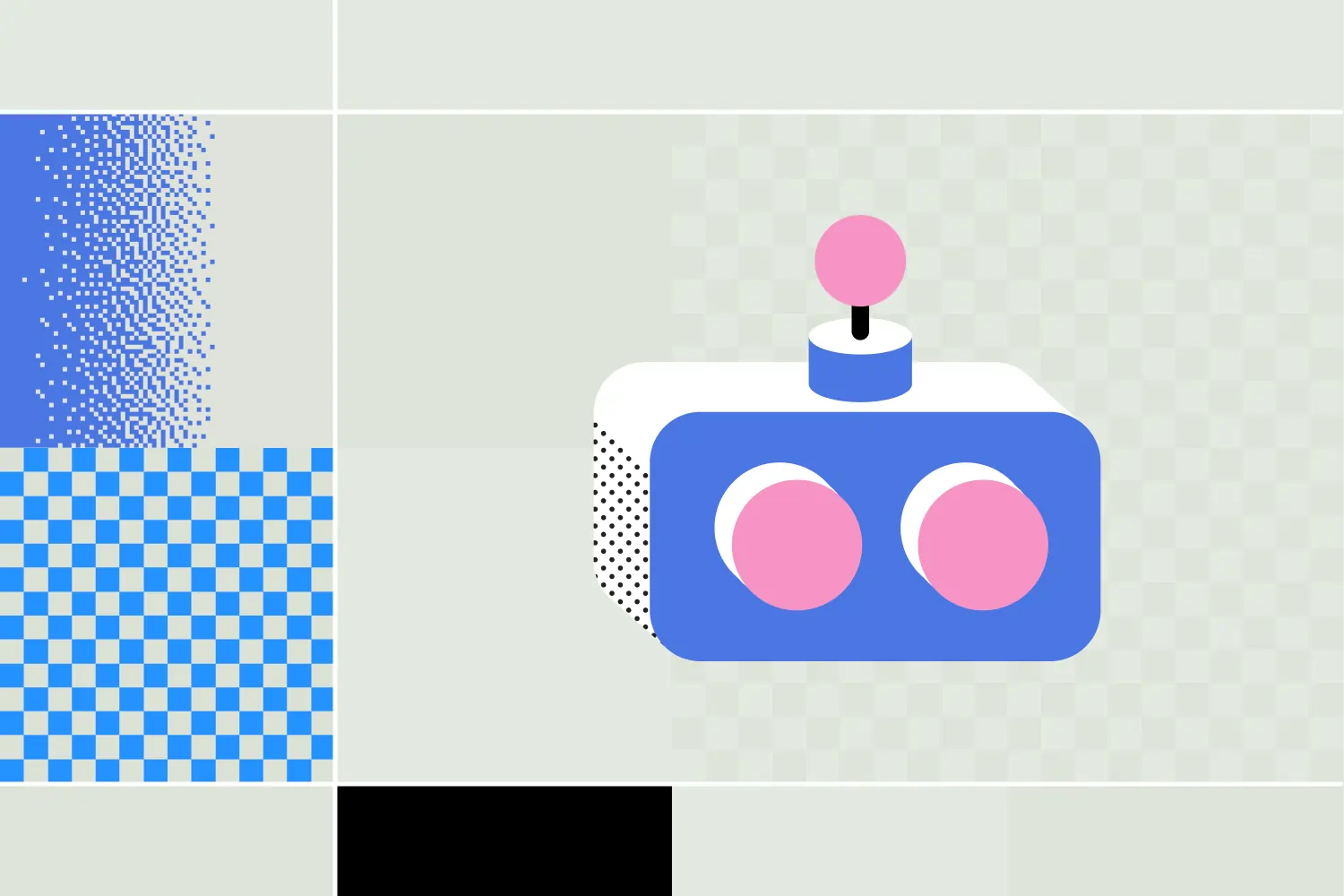




.webp)

